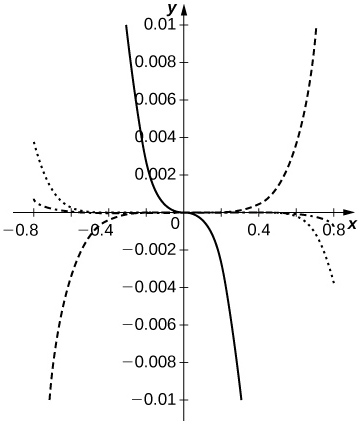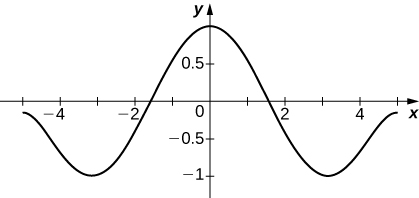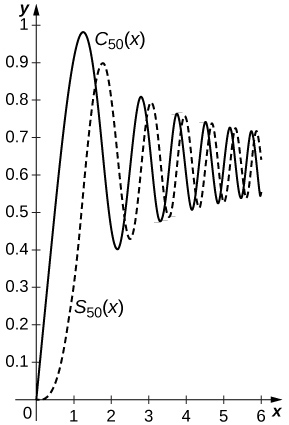5.4E: Exercises for Section 5.4
- Last updated
- Aug 15, 2022
- Save as PDF
- Page ID
- 110597
( \newcommand{\kernel}{\mathrm{null}\,}\)
In exercises 1 - 4, use appropriate substitutions to write down the Maclaurin series for the given binomial.
1) (1−x)1/3
2) (1+x2)−1/3
- Answer
- (1+x2)−1/3=∞∑n=0(n−13)x2n
3) (1−x)1.01
4) (1−2x)2/3
- Answer
- (1−2x)2/3=∞∑n=0(−1)n2n(n23)xn
In exercises 5 - 12, use the substitution (b+x)r=(b+a)r(1+x−ab+a)r in the binomial expansion to find the Taylor series of each function with the given center.
5) √x+2 at a=0
6) √x2+2 at a=0
- Answer
- √2+x2=∞∑n=02(1/2)−n(n12)x2n;(|x2|<2)
7) √x+2 at a=1
8) √2x−x2 at a=1 (Hint: 2x−x2=1−(x−1)2)
- Answer
- √2x−x2=√1−(x−1)2 so √2x−x2=∞∑n=0(−1)n(n12)(x−1)2n
9) (x−8)1/3 at a=9
10) √x at a=4
- Answer
- √x=2√1+x−44 so √x=∞∑n=021−2n(n12)(x−4)n
11) x1/3 at a=27
12) √x at x=9
- Answer
- √x=∞∑n=031−3n(n12)(x−9)n
In exercises 13 - 14, use the binomial theorem to estimate each number, computing enough terms to obtain an estimate accurate to an error of at most 1/1000.
13) [T] (15)1/4 using (16−x)1/4
14) [T] (1001)1/3 using (1000+x)1/3
- Answer
- 10(1+x1000)1/3=∞∑n=0101−3n(13n)xn. Using, for example, a fourth-degree estimate at x=1 gives (1001)1/3≈10(1+(113)10−3+(213)10−6+(313)10−9+(313)10−12)=10(1+13.103−19.106+581.109−10243.1012)=10.00333222... whereas (1001)1/3=10.00332222839093.... Two terms would suffice for three-digit accuracy.
In exercises 15 - 18, use the binomial approximation √1−x≈1−x2−x28−x316−5x4128−7x5256 for |x|<1 to approximate each number. Compare this value to the value given by a scientific calculator.
15) [T] 1√2 using x=12 in (1−x)1/2
16) [T] √5=5×1√5 using x=45 in (1−x)1/2
- Answer
- The approximation is 2.3152; the CAS value is 2.23….
17) [T] √3=3√3 using x=23 in (1−x)1/2
18) [T] √6 using x=56 in (1−x)1/2
- Answer
- The approximation is 2.583…; the CAS value is 2.449….
19) Integrate the binomial approximation of √1−x to find an approximation of ∫x0√1−tdt.
20) [T] Recall that the graph of √1−x2 is an upper semicircle of radius 1. Integrate the binomial approximation of √1−x2 up to order 8 from x=−1 to x=1 to estimate π2.
- Answer
- √1−x2=1−x22−x48−x616−5x8128+⋯. Thus ∫1−1√1−x2dx=[x−x36−x540−x77⋅16−5x99⋅128+⋯]|1−1≈2−13−120−156−109⋅128+error=1.590... whereas π2=1.570...
In exercises 21 - 24, use the expansion (1+x)1/3=1+13x−19x2+581x3−10243x4+⋯ to write the first five terms (not necessarily a quartic polynomial) of each expression.
21) (1+4x)1/3;a=0
22) (1+4x)4/3;a=0
- Answer
- (1+x)4/3=(1+x)(1+13x−19x2+581x3−10243x4+⋯)=1+4x3+2x29−4x381+5x4243+⋯
23) (3+2x)1/3;a=−1
24) (x2+6x+10)1/3;a=−3
- Answer
- (1+(x+3)2)1/3=1+13(x+3)2−19(x+3)4+581(x+3)6−10243(x+3)8+⋯
25) Use (1+x)1/3=1+13x−19x2+581x3−10243x4+⋯ with x=1 to approximate 21/3.
26) Use the approximation (1−x)2/3=1−2x3−x29−4x381−7x4243−14x5729+⋯ for |x|<1 to approximate 21/3=2.2−2/3.
- Answer
- Twice the approximation is 1.260… whereas 21/3=1.2599....
27) Find the 25th derivative of f(x)=(1+x2)13 at x=0.
28) Find the 99th derivative of f(x)=(1+x4)25.
- Answer
- f(99)(0)=0
In exercises 29 - 36, find the Maclaurin series of each function.
29) f(x)=xe2x
30) f(x)=2x
- Answer
- ∞∑n=0(ln(2)x)nn!
31) f(x)=sinxx
32) f(x)=sin(√x)√x,(x>0),
- Answer
- For x>0,sin(√x)=∞∑n=0(−1)nx(2n+1)/2√x(2n+1)!=∞∑n=0(−1)nxn(2n+1)!.
33) f(x)=sin(x2)
34) f(x)=ex3
- Answer
- ex3=∞∑n=0x3nn!
35) f(x)=cos2x using the identity cos2x=12+12cos(2x)
36) f(x)=sin2x using the identity sin2x=12−12cos(2x)
- Answer
- sin2x=−∞∑k=1(−1)k22k−1x2k(2k)!
In exercises 37 - 44, find the Maclaurin series of F(x)=∫x0f(t)dt by integrating the Maclaurin series of f term by term. If f is not strictly defined at zero, you may substitute the value of the Maclaurin series at zero.
37) F(x)=∫x0e−t2dt;f(t)=e−t2=∞∑n=0(−1)nt2nn!
38) F(x)=tan−1x;f(t)=11+t2=∞∑n=0(−1)nt2n
- Answer
- tan−1x=∞∑k=0(−1)kx2k+12k+1
39) F(x)=tanh−1x;f(t)=11−t2=∞∑n=0t2n
40) F(x)=sin−1x;f(t)=1√1−t2=∞∑k=0(k12)t2kk!
- Answer
- sin−1x=∞∑n=0(n12)x2n+1(2n+1)n!
41) F(x)=∫x0sinttdt;f(t)=sintt=∞∑n=0(−1)nt2n(2n+1)!
42) F(x)=∫x0cos(√t)dt;f(t)=∞∑n=0(−1)nxn(2n)!
- Answer
- F(x)=∞∑n=0(−1)nxn+1(n+1)(2n)!
43) F(x)=∫x01−costt2dt;f(t)=1−costt2=∞∑n=0(−1)nt2n(2n+2)!
44) F(x)=∫x0ln(1+t)tdt;f(t)=∞∑n=0(−1)ntnn+1
- Answer
- F(x)=∞∑n=1(−1)n+1xnn2
In exercises 45 - 52, compute at least the first three nonzero terms (not necessarily a quadratic polynomial) of the Maclaurin series of f.
45) f(x)=sin(x+π4)=sinxcos(π4)+cosxsin(π4)
46) f(x)=tanx
- Answer
- x+x33+2x515+⋯
47) f(x)=ln(cosx)
48) f(x)=excosx
- Answer
- 1+x−x33−x46+⋯
49) f(x)=esinx
50) f(x)=sec2x
- Answer
- 1+x2+2x43+17x645+⋯
51) f(x)=tanhx
52) f(x)=tan√x√x (see expansion for tanx)
- Answer
- Using the expansion for tanx gives 1+x3+2x215.
In exercises 53 - 56, find the radius of convergence of the Maclaurin series of each function.
53) ln(1+x)
54) 11+x2
- Answer
- 11+x2=∞∑n=0(−1)nx2n so R=1 by the ratio test.
55) tan−1x
56) ln(1+x2)
- Answer
- ln(1+x2)=∞∑n=1(−1)n−1nx2n so R=1 by the ratio test.
57) Find the Maclaurin series of sinhx=ex−e−x2.
58) Find the Maclaurin series of coshx=ex+e−x2.
- Answer
- Add series of ex and e−x term by term. Odd terms cancel and coshx=∞∑n=0x2n(2n)!.
59) Differentiate term by term the Maclaurin series of sinhx and compare the result with the Maclaurin series of coshx.
60) [T] Let Sn(x)=n∑k=0(−1)kx2k+1(2k+1)! and Cn(x)=n∑n=0(−1)kx2k(2k)! denote the respective Maclaurin polynomials of degree 2n+1 of sinx and degree 2n of cosx. Plot the errors Sn(x)Cn(x)−tanx for n=1,..,5 and compare them to x+x33+2x515+17x7315−tanx on (−π4,π4).
- Answer
-
The ratio Sn(x)Cn(x) approximates tanx better than does p7(x)=x+x33+2x515+17x7315 for N≥3. The dashed curves are SnCn−tanx for n=1,2. The dotted curve corresponds to n=3, and the dash-dotted curve corresponds to n=4. The solid curve is p7−tanx.

61) Use the identity 2sinxcosx=sin(2x) to find the power series expansion of sin2x at x=0. (Hint: Integrate the Maclaurin series of sin(2x) term by term.)
62) If y=∞∑n=0anxn, find the power series expansions of xy′ and x2y″.
- Answer
- By the term-by-term differentiation theorem, y′=∞∑n=1nanxn−1 so y′=∞∑n=1nanxn−1xy′=∞∑n=1nanxn, whereas y′=∞∑n=2n(n−1)anxn−2 so xy″=∞∑n=2n(n−1)anxn.
63) [T] Suppose that y=∞∑k=0akxk satisfies y′=−2xy and y(0)=0. Show that a2k+1=0 for all k and that a2k+2=−a2kk+1. Plot the partial sum S20 of y on the interval [−4,4].
64) [T] Suppose that a set of standardized test scores is normally distributed with mean μ=100 and standard deviation σ=10. Set up an integral that represents the probability that a test score will be between 90 and 110 and use the integral of the degree 10 Maclaurin polynomial of 1√2πe−x2/2 to estimate this probability.
- Answer
- The probability is p=1√2π∫(b−μ)/σ(a−μ)/σe−x2/2dx where a=90 and b=100, that is, p=1√2π∫1−1e−x2/2dx=1√2π∫1−15∑n=0(−1)nx2n2nn!dx=2√2π5∑n=0(−1)n1(2n+1)2nn!≈0.6827.
65) [T] Suppose that a set of standardized test scores is normally distributed with mean μ=100 and standard deviation σ=10. Set up an integral that represents the probability that a test score will be between 70 and 130 and use the integral of the degree 50 Maclaurin polynomial of 1√2πe−x2/2 to estimate this probability.
66) [T] Suppose that ∞∑n=0anxn converges to a function f(x) such that f(0)=1,f′(0)=0, and f″(x)=−f(x). Find a formula for an and plot the partial sum SN for N=20 on [−5,5].
- Answer
-
As in the previous problem one obtains an=0 if n is odd and an=−(n+2)(n+1)an+2 if n is even, so a0=1 leads to a2n=(−1)n(2n)!.

67) [T] Suppose that ∞∑n=0anxn converges to a function f(x) such that f(0)=0,f′(0)=1, and f″(x)=−f(x). Find a formula for an and plot the partial sum SN for N=10 on [−5,5].
68) Suppose that ∞∑n=0anxn converges to a function y such that y″−y′+y=0 where y(0)=1 and y′(0)=0. Find a formula that relates an+2,an+1, and an and compute a0,...,a5.
- Answer
- y″=∞∑n=0(n+2)(n+1)an+2xn and y′=∞∑n=0(n+1)an+1xn so y″−y′+y=0 implies that (n+2)(n+1)an+2−(n+1)an+1+an=0 or an=an−1n−an−2n(n−1) for all n⋅y(0)=a0=1 and y′(0)=a1=0, so a2=12,a3=16,a4=0, and a5=−1120.
69) Suppose that ∞∑n=0anxn converges to a function y such that y″−y′+y=0 where y(0)=0 and y′(0)=1. Find a formula that relates an+2,an+1, and an and compute a1,...,a5.
The error in approximating the integral ∫baf(t)dt by that of a Taylor approximation ∫baPn(t)dt is at most ∫baRn(t)dt. In exercises 70 - 71, the Taylor remainder estimate Rn≤M(n+1)!|x−a|n+1 guarantees that the integral of the Taylor polynomial of the given order approximates the integral of f with an error less than 110.
a. Evaluate the integral of the appropriate Taylor polynomial and verify that it approximates the CAS value with an error less than 1100.
b. Compare the accuracy of the polynomial integral estimate with the remainder estimate.
70) [T] ∫π0sinttdt;Ps=1−x23!+x45!−x67!+x89! (You may assume that the absolute value of the ninth derivative of sintt is bounded by 0.1.)
- Answer
- a. (Proof)
b. We have Rs≤0.1(9)!π9≈0.0082<0.01. We have ∫π0(1−x23!+x45!−x67!+x89!)dx=π−π33⋅3!+π55⋅5!−π77⋅7!+π99⋅9!=1.852..., whereas ∫π0sinttdt=1.85194..., so the actual error is approximately 0.00006.
71) [T] ∫20e−x2dx;p11=1−x2+x42−x63!+⋯−x2211! (You may assume that the absolute value of the 23rd derivative of e−x2 is less than 2×1014.)
The following exercises (72-73) deal with Fresnel integrals.
72) The Fresnel integrals are defined by C(x)=∫x0cos(t2)dt and S(x)=∫x0sin(t2)dt. Compute the power series of C(x) and S(x) and plot the sums CN(x) and SN(x) of the first N=50 nonzero terms on [0,2π].
- Answer
-
Since cos(t2)=∞∑n=0(−1)nt4n(2n)! and sin(t2)=∞∑n=0(−1)nt4n+2(2n+1)!, one has S(x)=∞∑n=0(−1)nx4n+3(4n+3)(2n+1)! and C(x)=∞∑n=0(−1)nx4n+1(4n+1)(2n)!. The sums of the first 50 nonzero terms are plotted below with C50(x) the solid curve and S50(x) the dashed curve.

73) [T] The Fresnel integrals are used in design applications for roadways and railways and other applications because of the curvature properties of the curve with coordinates (C(t),S(t)). Plot the curve (C50,S50) for 0≤t≤2π, the coordinates of which were computed in the previous exercise.
74) Estimate ∫1/40√x−x2dx by approximating √1−x using the binomial approximation 1−x2−x28−x316−5x42128−7x5256.
- Answer
- ∫1/40√x(1−x2−x28−x316−5x4128−7x5256)dx=232−3−12252−5−18272−7−116292−9−51282112−11−72562132−13=0.0767732... whereas \displaystyle ∫^{1/4}_0\sqrt{x−x^2}\, dx=0.076773.
75) [T] Use Newton’s approximation of the binomial \sqrt{1−x^2} to approximate π as follows. The circle centered at (\frac{1}{2},0) with radius \frac{1}{2} has upper semicircle y=\sqrt{x}\sqrt{1−x}. The sector of this circle bounded by the x-axis between x=0 and x=\frac{1}{2} and by the line joining (\frac{1}{4},\frac{\sqrt{3}}{4}) corresponds to \frac{1}{6} of the circle and has area \frac{π}{24}. This sector is the union of a right triangle with height \frac{\sqrt{3}}{4} and base \frac{1}{4} and the region below the graph between x=0 and x=\frac{1}{4}. To find the area of this region you can write y=\sqrt{x}\sqrt{1−x}=\sqrt{x}×(\text{binomial expansion of} \sqrt{1−x}) and integrate term by term. Use this approach with the binomial approximation from the previous exercise to estimate π.
76) Use the approximation T≈2π\sqrt{\frac{L}{g}}(1+\frac{k^2}{4}) to approximate the period of a pendulum having length 10 meters and maximum angle θ_{max}=\frac{π}{6} where k=\sin\left(\frac{θ_{max}}{2}\right). Compare this with the small angle estimate T≈2π\sqrt{\frac{L}{g}}.
- Answer
- T≈2π\sqrt{\frac{10}{9.8}}\left(1+\frac{\sin^2(θ/12)}{4}\right)≈6.453 seconds. The small angle estimate is T≈2π\sqrt{\frac{10}{9.8}≈6.347}. The relative error is around 2 percent.
77) Suppose that a pendulum is to have a period of 2 seconds and a maximum angle of θ_{max}=\frac{π}{6}. Use T≈2π\sqrt{\dfrac{L}{g}}\left(1+\dfrac{k^2}{4}\right) to approximate the desired length of the pendulum. What length is predicted by the small angle estimate T≈2π\sqrt{\frac{L}{g}}?
78) Evaluate \displaystyle ∫^{π/2}_0\sin^4θ\,dθ in the approximation \displaystyle T=4\sqrt{\frac{L}{g}}∫^{π/2}_0\left(1+\frac{1}{2}k^2\sin^2θ+\frac{3}{8}k^4\sin^4θ+⋯\right)\,dθ to obtain an improved estimate for T.
- Answer
- \displaystyle ∫^{π/2}_0\sin^4θ\, dθ=\frac{3π}{16}. Hence T≈2π\sqrt{\frac{L}{g}}\left(1+\frac{k^2}{4}+\frac{9}{256}k^4\right).
79) [T] An equivalent formula for the period of a pendulum with amplitude \displaystyle θ_{max} is T(θ_{max})=2\sqrt{2}\sqrt{\frac{L}{g}}∫^{θ_{max}}_0\frac{dθ}{\sqrt{\cos θ}−\cos(θ_{max})} where L is the pendulum length and g is the gravitational acceleration constant. When θ_{max}=\frac{π}{3} we get \dfrac{1}{\sqrt{\cos t−1/2}}≈\sqrt{2}\left(1+\frac{t^2}{2}+\frac{t^4}{3}+\frac{181t^6}{720}\right). Integrate this approximation to estimate T(\frac{π}{3}) in terms of L and g. Assuming g=9.806 meters per second squared, find an approximate length L such that T(\frac{π}{3})=2 seconds.
Contributors
Gilbert Strang (MIT) and Edwin “Jed” Herman (Harvey Mudd) with many contributing authors. This content by OpenStax is licensed with a CC-BY-SA-NC 4.0 license. Download for free at http://cnx.org.


